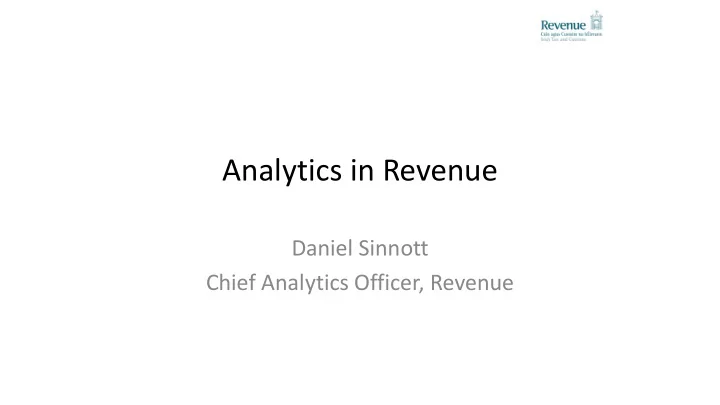

Analytics in Revenue Daniel Sinnott Chief Analytics Officer, Revenue
What I will cover this morning • Governance & infrastructure Organisational • set-up Capability development • Data sources Analytical approaches • Analytical methods • Data quality & representativeness Challenges & opportunities • Natural taxation Theme: Just because it’s quantitative, doesn’t mean it’s informative!
Types of operational data use in Revenue Hypothesis-based Rules-based Analytics-based Anomaly detection Predictive modelling REAP RCTs Increasing complexity Data query SNA tools Targeted projects More More reliant on reliant experts on data
Organisational set-up
Strong governance ensures IT, operations, and analytics work together effectively Revenue Analytics Group Analytics Operations IT Outputs that are technically robust, statistically sound, and operationally useful 5
Data processes & warehouse designed specifically for analytics • Metadata key to realising value from diverse data-holdings – Full tracking of data lineage in place – Populate metadata as tables are created – Working with dev teams to ensure metadata is created at source where possible • Software platform meets specific needs of analytics function – Performance & reliability – Handles unstructured and semi- structured data – Access to a wide range of tools for data exploration and modelling – Strong data governance
Developing capabilities in-house Identify and Recruit: ‐ Seek out suitable talent in – house ‐ Look for enthusiasm, and a background in natural or social sciences Develop and Retain: ‐ Focus on developing programming skills ‐ Blend online and classroom training ‐ Provide diverse opportunities 7
Analytical approaches
Overview of Revenue Data Sources Internal External - Domestic External - Foreign • • Tax returns • Government bodies Automatic exchange • • Intervention Banks of information: • outcomes Merchant acquirers • Income & assets Structured • • Filing behaviour Letting agents • Breakdown of • • Registrations General corporate • Payments requirements – e.g., activities Form 46G • • Phone calls • Suspicious Tax rulings • Emails • Transaction Reports Spontaneous • • Unstructured Letters Good Citizen exchanges • Case notes Reports • Sundry other (eg. Panama Papers) Revenue draws in millions of records annually – only selected sources shown here
Our ideal project: Models supervised by past intervention outcomes Train Validate Deploy y y • Work recommended cases and review model performance • Integrate model into Revenue case selection process • Currently used for VAT & PAYE repayments; three new models ready for testing x x Yield > €5k Yield < €5k But case selection process may introduce substantial bias…
A compromise: Models for anomaly detection Peer Groups (Mineral Oils, Construction) Predicted Values (Income-Consumption) Analytics allows us to make sophisticated comparisons between taxpayers to identify outliers
A sideline: Use analytics to predict response to intervention Approach taken Model output % claiming online • Business objective to target Mailed group campaigns aimed at persuading Control group taxpayers to claim expenses online Response • Initial hypothesis was that younger taxpayers should be targeted • Controlled experiment run to assess incremental impact; model(s) built to ‘predict’ experimental results • Found that older taxpayers responded more strongly Age Predicting outcomes is not the same as predicting response 12
Challenges & opportunities
Why we are embracing a ‘low - tech’ approach Challenges Implications • Unrepresentative training sets • Many relationships are just artefacts of data • Variation in system usage, etc • Can’t just automate search for predictive patterns (Attempted) Solution ‘Low - tech’ methods that business experts can review and understand make it much easier to weed out spurious patterns
Data without analytics? Traditional Natural Taxation Taxation Burden • Manual submission • Automatic submission Convenience • Real-time exchange • Periodic reporting Timeliness • Immediate checking • Self-reported against counter-party Corroboration and 3 rd party returns Already under way through eRCT and PAYE real-time; Opportunity to make compliance the default setting
Recommend
More recommend